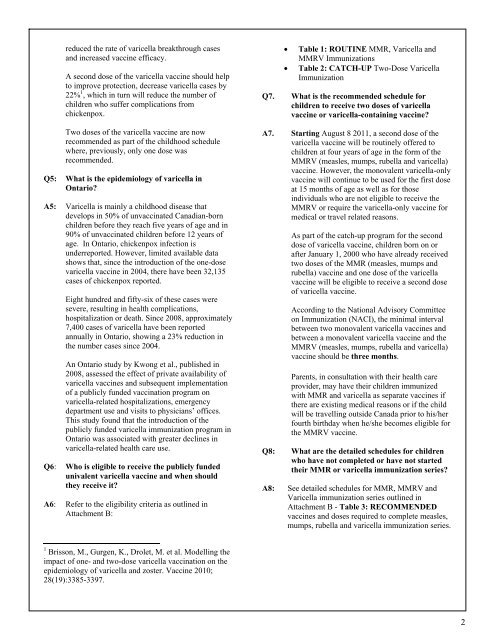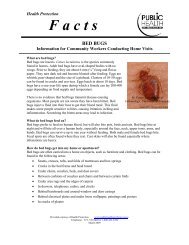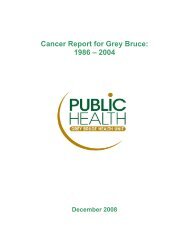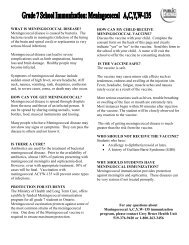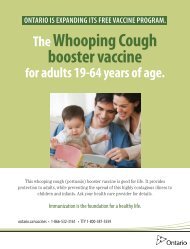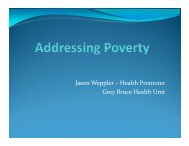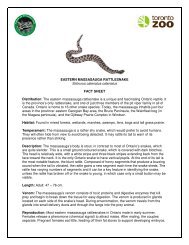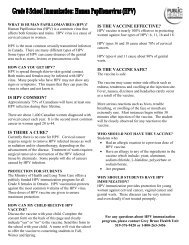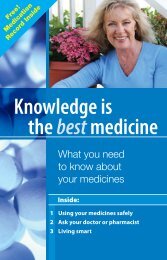Two-dose varicella program
Two-dose varicella program
Two-dose varicella program
You also want an ePaper? Increase the reach of your titles
YUMPU automatically turns print PDFs into web optimized ePapers that Google loves.
educed the rate of <strong>varicella</strong> breakthrough cases<br />
and increased vaccine efficacy.<br />
A second <strong>dose</strong> of the <strong>varicella</strong> vaccine should help<br />
to improve protection, decrease <strong>varicella</strong> cases by<br />
22% 1 , which in turn will reduce the number of<br />
children who suffer complications from<br />
chickenpox.<br />
<strong>Two</strong> <strong>dose</strong>s of the <strong>varicella</strong> vaccine are now<br />
recommended as part of the childhood schedule<br />
where, previously, only one <strong>dose</strong> was<br />
recommended.<br />
Q5: What is the epidemiology of <strong>varicella</strong> in<br />
Ontario<br />
A5: Varicella is mainly a childhood disease that<br />
develops in 50% of unvaccinated Canadian-born<br />
children before they reach five years of age and in<br />
90% of unvaccinated children before 12 years of<br />
age. In Ontario, chickenpox infection is<br />
underreported. However, limited available data<br />
shows that, since the introduction of the one-<strong>dose</strong><br />
<strong>varicella</strong> vaccine in 2004, there have been 32,135<br />
cases of chickenpox reported.<br />
Eight hundred and fifty-six of these cases were<br />
severe, resulting in health complications,<br />
hospitalization or death. Since 2008, approximately<br />
7,400 cases of <strong>varicella</strong> have been reported<br />
annually in Ontario, showing a 23% reduction in<br />
the number cases since 2004.<br />
An Ontario study by Kwong et al., published in<br />
2008, assessed the effect of private availability of<br />
<strong>varicella</strong> vaccines and subsequent implementation<br />
of a publicly funded vaccination <strong>program</strong> on<br />
<strong>varicella</strong>-related hospitalizations, emergency<br />
department use and visits to physicians’ offices.<br />
This study found that the introduction of the<br />
publicly funded <strong>varicella</strong> immunization <strong>program</strong> in<br />
Ontario was associated with greater declines in<br />
<strong>varicella</strong>-related health care use.<br />
Q6: Who is eligible to receive the publicly funded<br />
univalent <strong>varicella</strong> vaccine and when should<br />
they receive it<br />
A6: Refer to the eligibility criteria as outlined in<br />
Attachment B:<br />
• Table 1: ROUTINE MMR, Varicella and<br />
MMRV Immunizations<br />
• Table 2: CATCH-UP <strong>Two</strong>-Dose Varicella<br />
Immunization<br />
Q7. What is the recommended schedule for<br />
children to receive two <strong>dose</strong>s of <strong>varicella</strong><br />
vaccine or <strong>varicella</strong>-containing vaccine<br />
A7. Starting August 8 2011, a second <strong>dose</strong> of the<br />
<strong>varicella</strong> vaccine will be routinely offered to<br />
children at four years of age in the form of the<br />
MMRV (measles, mumps, rubella and <strong>varicella</strong>)<br />
vaccine. However, the monovalent <strong>varicella</strong>-only<br />
vaccine will continue to be used for the first <strong>dose</strong><br />
at 15 months of age as well as for those<br />
individuals who are not eligible to receive the<br />
MMRV or require the <strong>varicella</strong>-only vaccine for<br />
medical or travel related reasons.<br />
As part of the catch-up <strong>program</strong> for the second<br />
<strong>dose</strong> of <strong>varicella</strong> vaccine, children born on or<br />
after January 1, 2000 who have already received<br />
two <strong>dose</strong>s of the MMR (measles, mumps and<br />
rubella) vaccine and one <strong>dose</strong> of the <strong>varicella</strong><br />
vaccine will be eligible to receive a second <strong>dose</strong><br />
of <strong>varicella</strong> vaccine.<br />
According to the National Advisory Committee<br />
on Immunization (NACI), the minimal interval<br />
between two monovalent <strong>varicella</strong> vaccines and<br />
between a monovalent <strong>varicella</strong> vaccine and the<br />
MMRV (measles, mumps, rubella and <strong>varicella</strong>)<br />
vaccine should be three months.<br />
Parents, in consultation with their health care<br />
provider, may have their children immunized<br />
with MMR and <strong>varicella</strong> as separate vaccines if<br />
there are existing medical reasons or if the child<br />
will be travelling outside Canada prior to his/her<br />
fourth birthday when he/she becomes eligible for<br />
the MMRV vaccine.<br />
Q8: What are the detailed schedules for children<br />
who have not completed or have not started<br />
their MMR or <strong>varicella</strong> immunization series<br />
A8: See detailed schedules for MMR, MMRV and<br />
Varicella immunization series outlined in<br />
Attachment B - Table 3: RECOMMENDED<br />
vaccines and <strong>dose</strong>s required to complete measles,<br />
mumps, rubella and <strong>varicella</strong> immunization series.<br />
1 Brisson, M., Gurgen, K., Drolet, M. et al. Modelling the<br />
impact of one- and two-<strong>dose</strong> <strong>varicella</strong> vaccination on the<br />
epidemiology of <strong>varicella</strong> and zoster. Vaccine 2010;<br />
28(19):3385-3397.<br />
2


